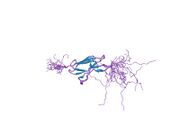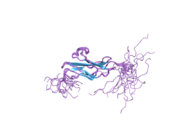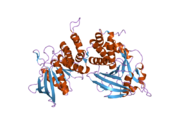Biology:PTPRD
 Generic protein structure example |
Receptor-type tyrosine-protein phosphatase delta is an enzyme that, in humans, is encoded by the PTPRD gene.[1][2][3]
Function
The protein encoded by this gene is a member of the protein tyrosine phosphatase (PTP) family. PTPs are known to be signaling molecules that regulate a variety of cellular processes including cell growth, differentiation, mitotic cycle, and oncogenic transformation. This PTP contains an extracellular region, a single transmembrane segment and two tandem intracytoplasmic catalytic domains, thus represents a receptor-type PTP. The extracellular region of this protein is composed of three Ig-like and eight fibronectin type III-like domains. Studies of the similar genes in chick and fly suggest the role of this PTP is in promoting neurite growth, and regulating neurons axon guidance. Multiple tissue specific alternatively spliced transcript variants of this gene have been reported.[3]
Clinical significance
Mutations in the PTPRD gene are associated with autism,[4] obsessive–compulsive disorder,[5] and breast cancer.[6]
Interactions
PTPRD has been shown to interact with PTPRS[7] and liprin-alpha-1.[8]
References
- ↑ "Molecular characterization of the human transmembrane protein-tyrosine phosphatase delta. Evidence for tissue-specific expression of alternative human transmembrane protein-tyrosine phosphatase delta isoforms". J Biol Chem 270 (12): 6722–8. Apr 1995. doi:10.1074/jbc.270.12.6722. PMID 7896816.
- ↑ "MPTP delta, a putative murine homolog of HPTP delta, is expressed in specialized regions of the brain and in the B-cell lineage". Mol Cell Biol 13 (9): 5513–23. Sep 1993. doi:10.1128/MCB.13.9.5513. PMID 8355697.
- ↑ 3.0 3.1 "Entrez Gene: PTPRD protein tyrosine phosphatase, receptor type, D". https://www.ncbi.nlm.nih.gov/sites/entrez?Db=gene&Cmd=ShowDetailView&TermToSearch=5789.
- ↑ "Autism Is Associated with Inherited Deletions in PTPRD and NCAM2". PAS 2010; Abstract 2320.1. Pediatric Academic Societies. 2010. http://www.abstracts2view.com/pas/view.php?nu=PAS10L1_120&terms.
- ↑ "OCD: New Genetic Marker Reported". 2014-06-07. http://guardianlv.com/2014/06/ocd-new-genetic-marker-reported/.
- ↑ "Comprehensive molecular portraits of human breast tumours". Nature 490 (7418): 61–70. October 2012. doi:10.1038/nature11412. PMID 23000897. Bibcode: 2012Natur.490...61T.
- ↑ "The second catalytic domain of protein tyrosine phosphatase delta (PTP delta) binds to and inhibits the first catalytic domain of PTP sigma". Mol. Cell. Biol. 18 (5): 2608–16. May 1998. doi:10.1128/MCB.18.5.2608. PMID 9566880.
- ↑ "The LAR/PTP delta/PTP sigma subfamily of transmembrane protein-tyrosine-phosphatases: multiple human LAR, PTP delta, and PTP sigma isoforms are expressed in a tissue-specific manner and associate with the LAR-interacting protein LIP.1". Proc. Natl. Acad. Sci. U.S.A. 92 (25): 11686–90. Dec 1995. doi:10.1073/pnas.92.25.11686. PMID 8524829. Bibcode: 1995PNAS...9211686P.
Further reading
- "Structural diversity and evolution of human receptor-like protein tyrosine phosphatases.". EMBO J. 9 (10): 3241–52. 1990. doi:10.1002/j.1460-2075.1990.tb07523.x. PMID 2170109.
- "The mouse gene Ptprf encoding the leukocyte common antigen-related molecule LAR: cloning, characterization, and chromosomal localization.". Genomics 27 (1): 124–30. 1995. doi:10.1006/geno.1995.1014. PMID 7665159.
- "The LAR/PTP delta/PTP sigma subfamily of transmembrane protein-tyrosine-phosphatases: multiple human LAR, PTP delta, and PTP sigma isoforms are expressed in a tissue-specific manner and associate with the LAR-interacting protein LIP.1.". Proc. Natl. Acad. Sci. U.S.A. 92 (25): 11686–90. 1996. doi:10.1073/pnas.92.25.11686. PMID 8524829.
- "Physical mapping of receptor type protein tyrosine phosphatase sigma (PTPRS) to human chromosome 19p13.3.". Genomics 38 (1): 76–8. 1997. doi:10.1006/geno.1996.0594. PMID 8954782.
- "The second catalytic domain of protein tyrosine phosphatase delta (PTP delta) binds to and inhibits the first catalytic domain of PTP sigma.". Mol. Cell. Biol. 18 (5): 2608–16. 1998. doi:10.1128/MCB.18.5.2608. PMID 9566880.
- "Liprins, a family of LAR transmembrane protein-tyrosine phosphatase-interacting proteins.". J. Biol. Chem. 273 (25): 15611–20. 1998. doi:10.1074/jbc.273.25.15611. PMID 9624153.
- "Multiple interactions between receptor protein-tyrosine phosphatase (RPTP) alpha and membrane-distal protein-tyrosine phosphatase domains of various RPTPs.". J. Biol. Chem. 275 (17): 12446–52. 2000. doi:10.1074/jbc.275.17.12446. PMID 10777529.
- "Intra- and intermolecular interactions between intracellular domains of receptor protein-tyrosine phosphatases.". J. Biol. Chem. 277 (49): 47263–9. 2003. doi:10.1074/jbc.M205810200. PMID 12376545.
- "MIM-B, a putative metastasis suppressor protein, binds to actin and to protein tyrosine phosphatase delta.". Biochem. J. 371 (Pt 2): 463–71. 2003. doi:10.1042/BJ20021962. PMID 12570871.
- "An unappreciated role for RNA surveillance.". Genome Biol. 5 (2): R8. 2005. doi:10.1186/gb-2004-5-2-r8. PMID 14759258.
- "Identification of chromosome arm 9p as the most frequent target of homozygous deletions in lung cancer.". Genes Chromosomes Cancer 44 (4): 405–14. 2005. doi:10.1002/gcc.20253. PMID 16114034.
- "Allelic imbalances and microdeletions affecting the PTPRD gene in cutaneous squamous cell carcinomas detected using single nucleotide polymorphism microarray analysis.". Genes Chromosomes Cancer 46 (7): 661–9. 2007. doi:10.1002/gcc.20447. PMID 17420988.






